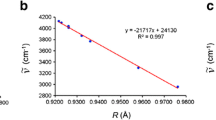Conclusions
On the basis of results of the biological study of the analogs synthesized, it has been established that the interaction of the tryptophanyl residue of the tetrapeptide of gastrin with the receptor is performed mainly through London electrokinetic forces.
Similar content being viewed by others
References
I. S. Morley, H. J. Tracy, and R. A. Gregory, Nature, 207, 1356, 1965.
I. S. Morley, Proc. Roy. Soc. B., 170, 97, 1968.
Z. A. Atare, V. S. Vilka, and G. I. Chipens, KhPS [Chemistry of Natural Compounds], 5, 283, 1969.
J. H. de Boer, Trans. Farad. Soc., 32, 10, 1936.
Author information
Authors and Affiliations
Additional information
Khimiya Prirodnykh Soedinenii, Vol. 6, No. 1, pp. 117–119, 1970
Rights and permissions
About this article
Cite this article
Chipens, G.I., Vilka, V.S. & Atare, Z.A. Analogs of the tetrapeptide gastrin with a modified tryptophan residue. Chem Nat Compd 6, 108–110 (1970). https://doi.org/10.1007/BF00564172
Published:
Issue Date:
DOI: https://doi.org/10.1007/BF00564172




